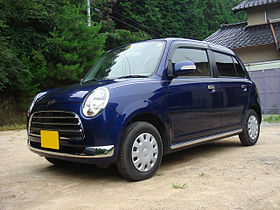Daihatsu Mira Gino
This article needs additional citations for verification. (February 2024) |
| Daihatsu Mira Gino | |
|---|---|
 | |
| Overview | |
| Manufacturer | Daihatsu |
| Also called | Daihatsu Trevis (Europe, 2004–2009) |
| Production | March 1999 – March 2009 |
| Body and chassis | |
| Class | |
| Layout | |
| Chronology | |
| Predecessor | Daihatsu Mira Classic |
| Successor | Daihatsu Mira Cocoa |
The Daihatsu Mira Gino (Japanese: ダイハツ・ミラジーノ, Daihatsu Mira Jīno) is a kei car/city car with distinctive retro styling made by the Japanese automaker Daihatsu from 1999 to 2009. It is based on the more mainstream Mira and was first introduced to the Japanese market in 1999, with the second generation model following in 2004. The Mira Gino replaced the Mira Classic which is a subvariant of the L500 series Mira. The second generation model was also exported as the Daihatsu Trevis to some markets in Europe such as Germany, the Netherlands, Italy, Gibraltar and France.
First generation (L700; 1999)[edit]
| First generation (L700) | |
|---|---|
 | |
| Overview | |
| Production |
|
| Body and chassis | |
| Body style |
|
| Related | |
| Powertrain | |
| Engine | |
| Power output |
|
| Transmission | |
| Dimensions | |
| Wheelbase | 2,360 mm (92.9 in) |
| Length |
|
| Width |
|
| Height | 1,425 mm (56.1 in) |
| Kerb weight | 830 kg (1,830 lb) (Mira Gino 1000) |
| Chronology | |
| Successor | Daihatsu Boon (Mira Gino 1000) |
The first generation Mira Gino was introduced in 1999 and was available in either three or five-door versions. The car is based on the L700 series Mira, which was produced between 1998 and 2002. The car was originally only available with the 658 cc EF series inline-three petrol engine, in naturally aspirated or turbocharged. Either front- or four-wheel drive is available. It features a retro styling, which evokes the design of the Compagno and the classic Mini.
An unusual development was the installation of the European market 989 cc EJ-VE inline-three petrol engine in the Mira Gino 1000, presented in August 2002. This version no longer fit into the "kei" class because of its larger engine and was also marginally longer and wider due to the installation of bumper overriders and fender trim.[1] The bigger engine produced 64 PS (47 kW) at 6,000 rpm, the same peak power as the turbocharged 658 cc engine, but offered considerably more power at lower engine speeds. 1,292 units of the Gino 1000 had been built when production came to an end in June 2004.[1] The only transmission option was a four-speed automatic, which was available with either front- or four-wheel drive. There was a base model and a better equipped "X" version. The Gino 1000 underwent no stylistic or mechanical changes during its production run.[2] It was effectively replaced by the 1.0 L variant of the Boon. The kei class Mira Gino was kept in production until November 2004.
- Daihatsu Mira Gino 1000
- Rear view
- Interior
Second generation (L650; 2004)[edit]
| Second generation (L650) | |
|---|---|
 | |
| Overview | |
| Also called | Daihatsu Trevis (Europe) |
| Production | November 2004 – March 2009 |
| Body and chassis | |
| Body style | 5-door hatchback |
| Related | |
| Powertrain | |
| Engine | |
| Transmission | 4-speed automatic, 5-speed manual |
| Dimensions | |
| Wheelbase | 2,390 mm (94.1 in) |
| Length | 3,395 mm (133.7 in) |
| Width | 1,475 mm (58.1 in) |
| Height | 1,515 mm (59.6 in) |
For the second generation model, the three-door version was dropped and it was only available as a five-door hatchback. Only the naturally aspirated EF-VE engine was available, still producing 58 PS (43 kW; 57 hp). It was cleaner than the eralier version, though, thanks to "intelligent catalysts". The Mira Gino was discontinued in March 2009 and replaced by the Mira Cocoa, also with retro styling albeit more original.
The styling was again inspired by the Mini, although this time the newer BMW-built Mini set the example.
- Daihatsu Mira Gino X Limited (L660S, Japan)
- Daihatsu Trevis
References[edit]
- ^ a b Ogawara, Kazuyo, ed. (2015-06-30), 週刊 日本の名車 [Famous Japanese Cars Weekly], Tokyo: K.K. DeAgostini Japan, p. 19
- ^ Ogawara 2015, p. 20.


 French
French Deutsch
Deutsch



